|
|
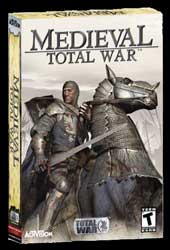
    
by Activision
|
 Medieval: Total
War defines the difference between casual and hard-core gaming. People
who are looking for a quick in and out game, those who spend the
majority of their gaming day playing Monopoly on Yahoo!, won’t want to
turn to Total War’s latest release unless they’re looking for a change.
Stuffed so full of intricate details that it’s near bursting with
historical flavor, the game offers a level of complexity that is almost
unheard of, nearly to the point of flaw. How detailed? I did a rough
word-count of the manual and came up with around 10,000 words. That’s
about an eighth of the length of the average novel, just covering the
details of the game. Filled with literally over a hundred types of
units, detailed historical descriptions of each of the European factions
over a 400-year time period, and complex tactical battles, Medieval
could drive the most historically oriented into breakdown. In other
words, it’s a great game; built with extraordinary care, it’s probably
the most detailed and playable warfare simulation on the market. While
certainly not for everyone (I wasn’t kidding about the overload; I’ve
seen grown men -- manly men -- crumble to the floor weeping after only a
few minutes with games less complicated) it’s one of the few games that
can neatly claim to be a strategy game or a tactical game
interchangeably. And best of all, you can adjust the complexity,
assigning more or less control of micromanaged tasks to the computer.
With a little bit of practice and a quick jaunt through the tutorial,
you’ll be cruising through Medieval in a form about as simple as Risk,
or as complicated as… well, the political intrigue of the Middle-Ages. Medieval: Total
War defines the difference between casual and hard-core gaming. People
who are looking for a quick in and out game, those who spend the
majority of their gaming day playing Monopoly on Yahoo!, won’t want to
turn to Total War’s latest release unless they’re looking for a change.
Stuffed so full of intricate details that it’s near bursting with
historical flavor, the game offers a level of complexity that is almost
unheard of, nearly to the point of flaw. How detailed? I did a rough
word-count of the manual and came up with around 10,000 words. That’s
about an eighth of the length of the average novel, just covering the
details of the game. Filled with literally over a hundred types of
units, detailed historical descriptions of each of the European factions
over a 400-year time period, and complex tactical battles, Medieval
could drive the most historically oriented into breakdown. In other
words, it’s a great game; built with extraordinary care, it’s probably
the most detailed and playable warfare simulation on the market. While
certainly not for everyone (I wasn’t kidding about the overload; I’ve
seen grown men -- manly men -- crumble to the floor weeping after only a
few minutes with games less complicated) it’s one of the few games that
can neatly claim to be a strategy game or a tactical game
interchangeably. And best of all, you can adjust the complexity,
assigning more or less control of micromanaged tasks to the computer.
With a little bit of practice and a quick jaunt through the tutorial,
you’ll be cruising through Medieval in a form about as simple as Risk,
or as complicated as… well, the political intrigue of the Middle-Ages.
 Medieval is
not the first in the Total War series. It actually follows in the
footsteps of the highly praised Shogun: Total War, which was released
about two years ago. It was a complicated game, focusing on the mass
warfare of historical Japan – often with hundreds of troops on the
battlefield at once – that was hailed for its realistic portrayal of the
elements that affect battles, and its mixing of strategic and tactical
elements. Medieval deserves all the same praise, and is very
similar to Shogun, to the point of using the same 3D graphics engine as
they did in the original game, though with some changes. Medieval is
divided into two halves: the strategic and the tactical. Strategically,
Medieval: Total War looks and feels like a very complicated form of
Risk, complete with turn based movements. In this part of the game, you
are looking down upon a map of the world, and little figurines represent
the locations and sizes of your and your enemy’s various armies. Here
you’ll find a tremendous amount of complexity, both from the perspective
of resource management and political planning. You can assign spies and
assassins to various tasks, or marry off your daughters and royal blood
to solidify alliances with neighboring allies. You can also declare
wars, and micro-manage the development of your countries. As you take
over more and more areas on the map, you’ll also have to deal with
territory morale and loyalty, city building, and religious factors. Your
captured cities produce the units of your armies, providing that you
build the right type of training facilities to do Medieval is
not the first in the Total War series. It actually follows in the
footsteps of the highly praised Shogun: Total War, which was released
about two years ago. It was a complicated game, focusing on the mass
warfare of historical Japan – often with hundreds of troops on the
battlefield at once – that was hailed for its realistic portrayal of the
elements that affect battles, and its mixing of strategic and tactical
elements. Medieval deserves all the same praise, and is very
similar to Shogun, to the point of using the same 3D graphics engine as
they did in the original game, though with some changes. Medieval is
divided into two halves: the strategic and the tactical. Strategically,
Medieval: Total War looks and feels like a very complicated form of
Risk, complete with turn based movements. In this part of the game, you
are looking down upon a map of the world, and little figurines represent
the locations and sizes of your and your enemy’s various armies. Here
you’ll find a tremendous amount of complexity, both from the perspective
of resource management and political planning. You can assign spies and
assassins to various tasks, or marry off your daughters and royal blood
to solidify alliances with neighboring allies. You can also declare
wars, and micro-manage the development of your countries. As you take
over more and more areas on the map, you’ll also have to deal with
territory morale and loyalty, city building, and religious factors. Your
captured cities produce the units of your armies, providing that you
build the right type of training facilities to do
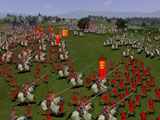 The result
is that you end up juggling a number of details simultaneously.
Loyalties are dictated by a variety of factors, including which general
you assign to overlook a region, and how his religion compares to that
of the local population. With only a few cities, you’ll quickly be
inundated with the task of assigning building resources (a thousand
little pop-up windows per turn), but fear not: part of the beauty of the
game is the ability to adjust your level of management detail. Don’t
want to worry about assigning generals? Then don’t. Let the computer
handle it. Same with the building of units and development of cities --
in fact, nearly everything. If you care little about the details of
running a thriving government, hand it over to your CPU and focus
instead on the tactical battles. Alternatively, if you care little about
being a general, you can choose to have the computer automatically
resolve conflicts. The entire game can be strongly tailored to your
tastes, to the point of never even seeing an enemy unit graphically
represented on the field of combat. The result
is that you end up juggling a number of details simultaneously.
Loyalties are dictated by a variety of factors, including which general
you assign to overlook a region, and how his religion compares to that
of the local population. With only a few cities, you’ll quickly be
inundated with the task of assigning building resources (a thousand
little pop-up windows per turn), but fear not: part of the beauty of the
game is the ability to adjust your level of management detail. Don’t
want to worry about assigning generals? Then don’t. Let the computer
handle it. Same with the building of units and development of cities --
in fact, nearly everything. If you care little about the details of
running a thriving government, hand it over to your CPU and focus
instead on the tactical battles. Alternatively, if you care little about
being a general, you can choose to have the computer automatically
resolve conflicts. The entire game can be strongly tailored to your
tastes, to the point of never even seeing an enemy unit graphically
represented on the field of combat.
 While the
political and strategic elements of Medieval are appealing nearly as a
game unto themselves (I spent most of my time here – but then, I used to
play games like Risk obsessively), it would be incredibly dense without
the tactical side of things. Every time you collide with another army in
the map room, you can choose to personally command your soldiers in
battle. Doing so often leads to fewer casualties, as a good general can
turn a losing battle facing depressing odds into a resounding victory
with a little clever thinking and skillful planning. Tactical battles
are fought from the perspective of a free flying aerial camera that
hovers above your troops and has a range limited to what your men can
see (though that setting can be turned off). The complexity of the
tactical battles is different than that found in the strategic Risk-like
micromanagement. Where in the map-room you spend a great deal of time
dealing with individual settings – who shall invade whom, what unit will
what city build – those sorts of details are handled automatically
during actual combat. Instead, the details appear in the outcomes.
Troops standing on a hill are in a better fighting position than those
at the bottom. Cavalry charging pike men will be less successful than
those charging foot infantry. The composition of your army is directly
related to how you make them up in the map room. If you had two units of
Cavalry, and combined them with a unit of foot soldiers, guess what
you’ll have when you go into battle? The box claims that you can have up
to 10,000 men on the field at one time, and while I can’t attest to that
many specifically (I never quite counted) I can tell you that the visual
appeal of watching hundreds of troops marching across the battlefield to
pounding music is more than capable of getting the blood flowing through
your veins. While the
political and strategic elements of Medieval are appealing nearly as a
game unto themselves (I spent most of my time here – but then, I used to
play games like Risk obsessively), it would be incredibly dense without
the tactical side of things. Every time you collide with another army in
the map room, you can choose to personally command your soldiers in
battle. Doing so often leads to fewer casualties, as a good general can
turn a losing battle facing depressing odds into a resounding victory
with a little clever thinking and skillful planning. Tactical battles
are fought from the perspective of a free flying aerial camera that
hovers above your troops and has a range limited to what your men can
see (though that setting can be turned off). The complexity of the
tactical battles is different than that found in the strategic Risk-like
micromanagement. Where in the map-room you spend a great deal of time
dealing with individual settings – who shall invade whom, what unit will
what city build – those sorts of details are handled automatically
during actual combat. Instead, the details appear in the outcomes.
Troops standing on a hill are in a better fighting position than those
at the bottom. Cavalry charging pike men will be less successful than
those charging foot infantry. The composition of your army is directly
related to how you make them up in the map room. If you had two units of
Cavalry, and combined them with a unit of foot soldiers, guess what
you’ll have when you go into battle? The box claims that you can have up
to 10,000 men on the field at one time, and while I can’t attest to that
many specifically (I never quite counted) I can tell you that the visual
appeal of watching hundreds of troops marching across the battlefield to
pounding music is more than capable of getting the blood flowing through
your veins.
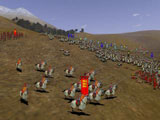 The audio
score is magnificent. Well, very good, at least. The artists obviously
tried to create music that fit well with the atmosphere of the game.
Battles are fought to the beat of pounding drums and the impassioned
cries ofsoldiers, accompanied by the stomping of horse hoofs and the
rattling of armor. In actuality, one of the game’s strong points has to
do with its feel, that dead-on accuracy with which they portray the
medieval environment: the opening graphics, the slow shadowy
figures that move silently behind your menu options before starting a
game. The elements flow together really well. The audio
score is magnificent. Well, very good, at least. The artists obviously
tried to create music that fit well with the atmosphere of the game.
Battles are fought to the beat of pounding drums and the impassioned
cries ofsoldiers, accompanied by the stomping of horse hoofs and the
rattling of armor. In actuality, one of the game’s strong points has to
do with its feel, that dead-on accuracy with which they portray the
medieval environment: the opening graphics, the slow shadowy
figures that move silently behind your menu options before starting a
game. The elements flow together really well.
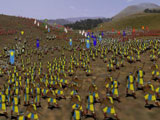 Of course,
there are several drawbacks to Medieval, but there are relatively few
annoying ones for a game of this complexity. For example, in the combat
simulations, the left and right arrows pivot your camera, like looking
straight out and turning in a circle. I would have much preferred a Myth
style camera instead, where the left and right arrow keys instead swivel
you around an object. Repositioning your camera so that you can see your
troops better can be difficult, as you have to lose sight of your troops
for a moment in the process of backing up, realigning, and zooming in
again. When it boils right down to it, this isn’t a huge deal; I managed
my troops pretty well regardless. Of course,
there are several drawbacks to Medieval, but there are relatively few
annoying ones for a game of this complexity. For example, in the combat
simulations, the left and right arrows pivot your camera, like looking
straight out and turning in a circle. I would have much preferred a Myth
style camera instead, where the left and right arrow keys instead swivel
you around an object. Repositioning your camera so that you can see your
troops better can be difficult, as you have to lose sight of your troops
for a moment in the process of backing up, realigning, and zooming in
again. When it boils right down to it, this isn’t a huge deal; I managed
my troops pretty well regardless.
 Additionally,
the game considers regrouping to be a retreat. There was one time where
half my army was routed; they started fleeing a field we were easily
winning just because they felt I was retreating too often. This came
about when I selected all my troops and assigned them a central
gathering spot, calling them off the fleeing enemy they were chasing,
and – as far as the computer was concerned -- retreating. It was rather
annoying to have a healthy, winning army turning tail when all you
wanted was for them to regroup two hundred feet away. This only happened
once, and I still won (though I lost points on my score…grrrr). Additionally,
the game considers regrouping to be a retreat. There was one time where
half my army was routed; they started fleeing a field we were easily
winning just because they felt I was retreating too often. This came
about when I selected all my troops and assigned them a central
gathering spot, calling them off the fleeing enemy they were chasing,
and – as far as the computer was concerned -- retreating. It was rather
annoying to have a healthy, winning army turning tail when all you
wanted was for them to regroup two hundred feet away. This only happened
once, and I still won (though I lost points on my score…grrrr).
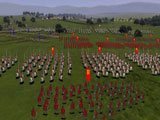 The only
significant complaint I have (and it’s not that significant when
compared to some other games) deals with the political elements of the
game. Through the battle map you can judge an enemy’s strengths,
weaknesses, alliances, and land ownership. This is a very important
element of the game. I don’t want to form an alliance with a weak
monarch with lots of land I might want to take from him. The problem
comes when someone offers you an alliance. Say a Spanish emissary comes
and offers a treaty. An image pops up, and the screen locks. Until you
accept or decline that offer, you can do nothing. This means you can’t
look around to see how many armies he has on your borders; you can’t
judge his military strength, or the position of his country on the map.
Unless you memorized all of this information about the thirteen
countries that you haven’t yet absorbed, alliances become a bit of a
guessing game. In a game this complicated, where the fates of nations
hang on such decisions, this shouldn’t be an issue. Aside from that, the
complaints fall into the annoying category, like the fact that the
"destroy" button when looking at your buildings is where most people
would assume the OK button is. These are problems, they’re there, and
you can’t deny them, but they don’t really interfere with the game.
After you identify and get used to them, they pretty much disappear from
sight. Sure, it would have been nice to have clearer color distinctions
between countries on the political map, but I’ll live with the tiny line
that’s currently there. The only
significant complaint I have (and it’s not that significant when
compared to some other games) deals with the political elements of the
game. Through the battle map you can judge an enemy’s strengths,
weaknesses, alliances, and land ownership. This is a very important
element of the game. I don’t want to form an alliance with a weak
monarch with lots of land I might want to take from him. The problem
comes when someone offers you an alliance. Say a Spanish emissary comes
and offers a treaty. An image pops up, and the screen locks. Until you
accept or decline that offer, you can do nothing. This means you can’t
look around to see how many armies he has on your borders; you can’t
judge his military strength, or the position of his country on the map.
Unless you memorized all of this information about the thirteen
countries that you haven’t yet absorbed, alliances become a bit of a
guessing game. In a game this complicated, where the fates of nations
hang on such decisions, this shouldn’t be an issue. Aside from that, the
complaints fall into the annoying category, like the fact that the
"destroy" button when looking at your buildings is where most people
would assume the OK button is. These are problems, they’re there, and
you can’t deny them, but they don’t really interfere with the game.
After you identify and get used to them, they pretty much disappear from
sight. Sure, it would have been nice to have clearer color distinctions
between countries on the political map, but I’ll live with the tiny line
that’s currently there.
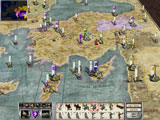 The game also
includes a map editor. This is a feature that’s relatively easy to use,
and lets you put together your own battlefields in which to crush your
best friend. This little added feature is a nice touch. It just goes to
show that there’s more in this box than you’d expect. With massive
single player battles, I can’t imagine what it would be like to have 8
players on the field at once. The game also
includes a map editor. This is a feature that’s relatively easy to use,
and lets you put together your own battlefields in which to crush your
best friend. This little added feature is a nice touch. It just goes to
show that there’s more in this box than you’d expect. With massive
single player battles, I can’t imagine what it would be like to have 8
players on the field at once.
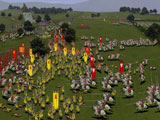 Overall, with
the level of detail and complexity that this game is capable of
encompassing, it’s amazing that there aren’t more complicated errors.
The fact that almost anyone can sit down and learn Medieval: Total War,
complications and all, without too much difficulty says something good
about the quality of the game. The adjustability and overall feel are
very well done--products of hard work and attention to detail both in
the user interface and design. While capable of overloading the player
with information, Medieval: Total War is still fun, engrossing, and
willing to scale itself back for the average user. And for those
non-average users? You won’t find a game that strives harder to match
your desire for detail, your demand for depth. Don’t be afraid to don
some armor; it’s a rewarding experience. Overall, with
the level of detail and complexity that this game is capable of
encompassing, it’s amazing that there aren’t more complicated errors.
The fact that almost anyone can sit down and learn Medieval: Total War,
complications and all, without too much difficulty says something good
about the quality of the game. The adjustability and overall feel are
very well done--products of hard work and attention to detail both in
the user interface and design. While capable of overloading the player
with information, Medieval: Total War is still fun, engrossing, and
willing to scale itself back for the average user. And for those
non-average users? You won’t find a game that strives harder to match
your desire for detail, your demand for depth. Don’t be afraid to don
some armor; it’s a rewarding experience.
Aaron Stanton (09/27/2002) |
|
Snapshot
Ups:
Incredible level of detail; great customization;
nice ambiance; definitely satisfies the hardcore strategy and tactical
fans.
Downs:
Probably too complicated for casual gamers; some
minor gameplay and interface issues.
Platform:
PC
|
|
|
|
|
|
|
|
